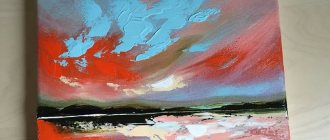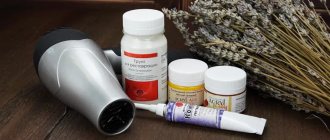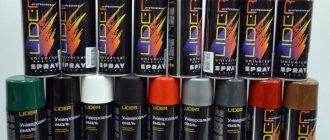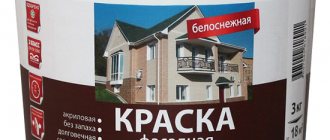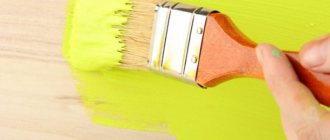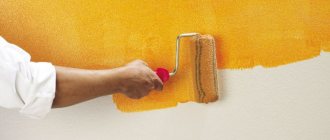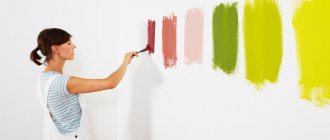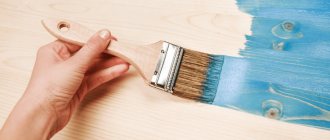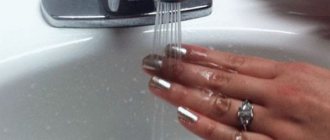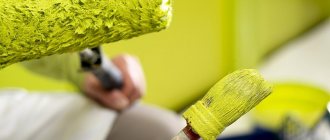Different types of paints help to refresh walls, ceilings or floors, give the room a new look, and make the facade attractive. And when choosing paint for certain jobs, people first of all pay attention to color and cost, missing such an important point as the time it takes for the paint to dry. And the drying time for paint varies, it all depends on the type of paint and the conditions under which it will dry. Construction portal Firststroy.ru will tell you how long different paints take to dry and how to speed up the drying process.
Are there “universal” paints with the same surface drying time?
The answer is clear - no. Universality is just a myth used by unscrupulous manufacturers solely for advertising purposes. At best, you buy paint with a one-time or very short-term effect. Therefore, you should not believe the manufacturer’s promises that the paint is equally ideal for repairing the paint surface of a car, for heating radiators, and for decorating a kitchen or bedroom. An excellent result will only be achieved if the paint is used for a specific purpose. In other cases, you will get a mediocre result and simply throw money away.
Often, when choosing, the decisive question is how long the paint takes to dry. This is objectively and directly related to its composition and the environmental conditions in which drying should occur. Why is it important? The pace of paint and varnish work has a direct impact on the overall speed of repair. For example, it is not recommended to carry out any other finishing work while the paint is drying. Otherwise, dust and other construction debris will simply stick to the painted surface.
Recommendations and useful tips for painting floors
The layer of paint that you apply to the surface should be as durable as possible. To do this, you should follow these simple tips:
- it is necessary to prepare the base in advance, eliminating all existing defects and contamination;
- Before painting the surface, you need to thoroughly saturate the base with a primer;
- It is better to apply the paint in several layers at once, since only in this case will it lie smoothly and beautifully;
- Although the paint does not have a strong odor, it is necessary to ventilate the room when the work process is completed.
Remember that the process of choosing a paint and varnish material must be taken as responsibly as possible. Repainting is an expensive and complex procedure, because it will not be easy to redo a failed result. Make a choice in favor of trusted manufacturers who guarantee the highest quality of their products.
Carefully study the product packaging to avoid making a mistake. Only in this case will paint allow you to cope with the tasks assigned to you quickly and efficiently.
How long does oil paint take to dry?
Oil-based paints traditionally take the longest to dry. In recent years, manufacturers have abandoned the use of natural drying oil for such compositions. Now in the mass production of oil paints, alkyd or pentaphthalic bases are used. This reduced the drying time of oil paints to one day.
Complete hardening of one layer occurs only as a result of oxidation of the upper oil layer. Factors that matter here include:
- air temperature;
- humidity;
- presence of direct sunlight.
Oil paints with the addition of antiseptic compounds take longer to dry. The period of time sufficient for drying of such and similar paints is indicated to the manufacturers on the can. In any case, drying time is at least 12 hours.
Kinds
Enamel is made from various fillers, which are combined with colored pigments and varnishes.
In addition, enamel can differ in structure: it is divided into primer, hammer, acrylic, nitro enamel, polyurethane and alkyd. The following types of enamels are most often chosen for painting floor coverings:
Alkyd
Alkyd. It is made from pentaphthalic and alkyd varnishes with the addition of antiseptic and marble chips. This enamel is dissolved with white spirit. The coloring agent has high technical characteristics, which include elasticity, water resistance and durability. Alkyd mixtures are also not afraid of temperature changes and retain their original color for a long time, so they are ideal for finishing floors in various rooms.
Polyurethane
Polyurethane. This dye contains many additives and has good adhesion. It can withstand not only low temperatures, but also mechanical stress.
Semi-gloss paint is very popular - it protects floors from abrasion and exposure to chemicals.
Acrylic
Acrylic. This is a universal, odorless mixture that forms an elastic layer on the coating surface that preserves the treated surface from damage.
This paint is available in a variety of colors. For flooring in apartments and houses, golden-brown enamel PF-226 is recommended. It originally emphasizes the natural beauty of wood and fills the interior of the rooms with an atmosphere of comfort.
Enamels and nitro paints
For most of these compositions, coating with a second layer is allowed within 20-30 minutes after applying the first layer. It takes about the same time for the second layer to dry. Manufacturers allow up to 12 hours for complete hardening so that painted products can be used.
Please note that nitro-based paints dry faster than enamels. This is also due to the primary areas of use of nitro paints and enamels. The former are mostly intended for painting metal and plastic surfaces (provided that the solvent in the paint base does not “eat” the plastic). Enamels can be used to cover any surface, including wood.
Sergey Yurievich
Construction of houses, extensions, terraces and verandas.
Ask a Question
For PF 115 enamel, for example, the drying time is directly related to the thickness of the layer applied during painting and the color of the paint. For example, it will take 48 hours for cherry and red enamel to dry. For everyone else, 24 hours is enough.
Some disadvantages
When paint with a high curing rate is applied, the following defects may appear:
- Uneven surfaces that are poorly sanded after puttying. Therefore, special attention should be paid to joints and seams on the base.
- The edges between individual sections will stand out if the compounds are applied with a time interval. Using quick-drying paints, it is recommended to cover the entire surface area completely in one go.
- When working with a brush, traces remain from its hairs if the composition is thick. Paint strokes do not have time to spread evenly over the surface, and it can quickly harden, forming corrugated stripes.
How long does it take for water-based emulsions to dry?
Water is considered the most environmentally friendly solvent for paints. Water-based emulsions, called water-dispersion paints, are used to paint almost any indoor surface.
For primary polymerization, 2-3 hours are enough. Complete drying within 24 hours. Some manufacturers produce water-dispersion paints with a complete drying time reduced to 12 hours. It is important that in conditions of high humidity, the drying time of water-based paints is practically unlimited.
Pay attention to the need for preliminary surface preparation for applying water-based emulsions. Otherwise, the dye layer may be completely absorbed into the surface being painted, leaving no traces of color on it or leaving only uneven stains.
Interestingly, water-based paint on the ceiling dries faster than on the walls. This is due to the fact that warm air currents always rise to the top, creating more favorable conditions for paint drying. But it takes at least 24 hours for complete drying.
Does the release form and method of application to the surface matter for paint drying?
The correct answer is yes. Paints in spray cans (aerosol) dry faster if they are applied to the surface in a thin layer.
Surfaces with a high level of porosity, for example, cement-sand plasters, also deserve special attention. Outwardly, it may seem that the paint on them has dried, but in fact it is far from dry. If painting is done on lime plaster, the consequences may be even worse due to the chemical reaction of lime with the paint base.
External circumstances influencing the hardening time of paints and varnishes
How long oil paint or any other paint takes to dry is primarily affected by the following points, determined by the characteristics of the material being painted and external conditions:
- Porosity. The abundant presence of pores on the treated surface actively contributes to the active absorption of the solution, which significantly accelerates its hardening. So, for example, on wallpaper, paint will dry much faster than on metal.
DIY wallpaper painting
- Ambient temperature . The process in question involves the evaporation of paint thinning substances. Heat, as you may remember from a school physics course, accelerates the movement of molecules. Consequently, polymerization occurs faster at high temperatures.
- Humidity level . Dry air helps draw moisture out of the paint, which, again, leads to faster drying. In a damp room, some compounds can remain in liquid form for a very long time.
- Active movement of air masses . High-quality ventilation promotes quick drying.
Advice: the most rational way to speed up the polymerization of paint and varnish material is to create a draft in the room. This will not only allow you to achieve what you want without the possibility of harming the finish, but will also help you quickly get rid of toxic fumes.
Open windows wide while painting
- Thickness of the applied layer . Everything is simple here: the thicker it is, the slower it is. And the thinnest spraying is carried out from a spray can.
Applying spray paint to a radiator
Advice: when using cans, it is recommended not only to protect the respiratory system with a respirator, but also to protect all exposed areas of the body. Since such compositions are usually very toxic, and during spraying they fill the entire surrounding space.
In general, the measures taken to speed up the drying process of a painted surface are the same as those for drying wet laundry. Judge for yourself: synthetics become dry much faster than porous cotton, and the best place for it is a rope in a ventilated part of the yard under the sun's rays.
The analogy with drying wet laundry
Hammer paint
Initially, this type of paint and varnish materials (LPMs) was used exclusively for application to industrial equipment. This type of dye received its name - hammer - due to the external similarity of the texture to the surface after hand-chasing with a hammer.
The composition is based on acrylic, alkyd-styrene or epoxy fillers. Additives include fine glass and aluminum powder. Due to them, particularly high strength of coatings is ensured after drying. It has a characteristic metallic sheen, which is why it is called metallic.
Approximate prices
Tikkuril acrylic paint has the following containers:
- 1.25 l costs 47.60 rubles.
- 0.9 l – 35 rub.
- 2.7 – 135 rub.
- Betolux Aqua semi-gloss with a capacity of 2.7 liters has a price of 91 rubles.
- “Belinka Aqua Email - antistatic Alicor enamel in 20 liter metal containers is sold at a price of 475 rubles/kg.
- Dulux Domus BW - 2.5 l costing 1,456 rubles.
- Polyurethane paint from RUB 335. per liter
- Latex rubber paint from 52 RUR/m2
Acrylic car paints
For the base of this type of paintwork materials, manufacturers use acrylic resins of synthetic origin. The advantages of their use are high thermostaticity (up to +180 degrees C) and complete neutrality to alkaline and acidic environments, alcohol and water. They practically do not fade when exposed to direct sunlight.
Ideal for coating metal car bodies, forming a particularly durable polymer film on the surface after drying. When applied to the body, a hardener is added to the base. Hardening of the layer on the surface of the car body occurs within 20 minutes, provided that the painting work is performed in a specially equipped paint booth with a high air temperature inside. But it takes 24 hours to dry completely.
The Montana paint deserves special attention. It takes only 15 minutes to dry on the surface of the car body.
Key Features
Surface painting materials that are odorless are ideal for floor surfaces. This innovative product is often used by people who cannot leave the painted room for several days.
Such paints for wooden or concrete floors have many significant advantages:
- the paint dries in minutes, so you don't have to spend a lot of time waiting for this process to complete;
- you do not have to put a mask or respirator on your face while working with paintwork;
- the absence of a strong chemical smell ensures that you will not be poisoned by harmful fumes;
- odorless floor paints contain no components hazardous to human health that could enter the respiratory tract, causing allergies;
- after painting, you will not have to move to another place for several days, because there will be no smell inside the room;
- Thanks to the versatility of the coating, you can carry out work not only inside, but also outside.
How long does it take for floor paint to dry?
If you are going to paint the floor, quick-drying acrylic enamels are perfect. In just a few hours you can begin to use the room, however, to ensure complete drying, it is recommended not to subject the floor surface to mechanical stress for at least 12 hours.
If you used oil paints the old-fashioned way, you need to check the drying time on the paint cans. Let us remind you once again that different manufacturers indicate different drying periods, this depends on the composition of the paint itself and some environmental factors.
When using PF 266 paint for the floor, application should be carried out only on dry, primed surfaces. The drying time of the first layer is at least 24 hours, after which the second layer can be applied. Complete drying of each layer – 24 hours.
How to work with finishing compounds and store them all year round
- If your workshop is not heated, move all jars of finishing compounds (especially water-based ones) to a warm room in the fall, and return them to the workshop in the spring.
- Do not store cans of finishing compounds and glue on a cold concrete floor in the basement.
- To warm the finishing compound to room temperature, place the jar in hot water (photo below) or place it next to a radiator for a few minutes. Do not heat the compound above the temperature of the wood you are going to apply it to. Do not use open flame for heating.
- After applying the composition, maintain a stable temperature in the room until the coating dries completely.
- If an air heating system is installed in the workshop, in order to save money, you should not turn on the circulation of warm air inside the room. It is necessary to ensure the flow of fresh air from the street, heating it to room temperature.
- Use a dehumidifier if your workshop is located in a damp basement.
- Do not apply another coat of coating unless the previous one is completely dry.
- Choose the best time to finish. As a rule, air temperature and humidity are lower in the morning. Never try to speed up drying by exposing the product to a sunlit area.
Reference by topic: How to apply varnish with a spray gun on a door
Silicone paint and drying time
The drying time for silicone paint at home is from several hours to several days. This process is influenced by a number of environmental factors - primarily humidity and air temperature,
If you dry products in a special chamber, during the first hour the air temperature should be raised to 100 degrees, and during the second hour - to 200 degrees. For complete drying in such conditions, 2 hours are enough.
You can ask your question to our author:
Expert opinions
A large range of dispersion acrylic enamels are resistant to moisture and resistant to fading. They contribute to the formation of a protective top layer on the floor surface, ensuring a long service life, and are therefore recommended for high-traffic areas.
Oil-based or wax-based compounds will not penetrate into wood, such as parquet flooring , as required by wear conditions.
This will not happen if the boards are coated with acrylic or polyurethane enamel based on organic solvents. Their cost is higher than oil paints, but the costs will be justified by the quality. The price range of modern rapid-hardening compositions ranges from 35 to 1,500 rubles per liter.
Video: tips for choosing odorless paint
There is a huge amount of modern materials on the construction market. It is difficult for inexperienced people to understand their properties without having the necessary information. If the choice of paint is limited only to the floor covering, then you should be interested in those compositions that are recommended for interior work and have universal properties. Next, you should decide on the material for which it will be used. The chemical composition of the subfloor determines its reaction to paint. For a veranda made of boards or cement, it will differ in that it must be resistant to moisture and ultraviolet radiation. In addition, other requirements are imposed on it. It must withstand frost and heat. If this is not taken into account, the paint will begin to crack and move away from the surface of the veranda floor.
Particular attention should be paid to preparing the base. To do this, apply primer to the sanded surface. It will create the necessary adhesion of the paint to the base. It is applied before finishing work begins. The use of primers will save on paint consumption for the first layer. In addition, they have special concentrated additives that protect the wood from fungus and damage by insects, and also level the surface, filling microcracks in it.
Advantages of painted floors
The market for construction and finishing materials has long been represented by paint and varnish products specifically designed for treating floor coverings. Moreover, the odorless floor paints sold are suitable for both wooden surfaces and ordinary concrete surfaces. The appearance of odorless coatings with a quick-drying effect made a real revolution. Advantages of coloring compositions:
- quick drying;
- safety;
- no pungent odor;
- abrasion resistance;
- color preservation;
- no sliding effect after treatment.
The problem of finding paint comes down to the question of which version of paint and varnish products is suitable in terms of properties.
